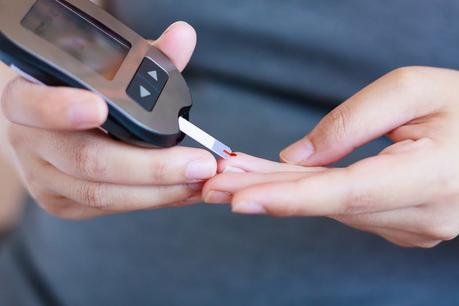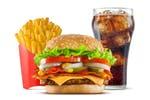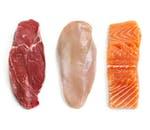What are the risks of type 1 diabetes?
People with type 1 diabetes are at increased risk for a number of health issues, including heart disease, kidney disease, loss of vision, nerve damage and amputations.
Importantly, these risks appear to be entirely due to poorly-controlled blood sugar, not simply having diabetes.
The American Diabetes Association has set the following blood sugar targets for people with diabetes who are otherwise healthy:
- Fasting blood glucose: 80-130 mg/dL (4.4 - 7.2 mmol/L)
- 2-hour postprandial (post-meal) blood glucose: less than 180 mg/dL (10 mmol/L)
- HbA1c: less than 7%
These numbers are quite a bit higher than what are considered healthy values for people without diabetes or even prediabetes. Healthy people typically have fasting blood sugar levels below 100 mg/dL (5.5 mmol/L) and rarely experience blood sugars greater than 120 mg/dL (6.7 mmol/L) after eating. Additionally, a normal A1c is considered 5.5% or less.
Indeed, the DCCT trial, which followed more than 1,400 people with type 1 diabetes for nine years, demonstrated that maintaining normal blood sugar levels may lead to fewer diabetes complications and decrease overall mortality risk.
This tighter blood sugar control in the DCCT trial, however, came with an increased risk of hypoglycemic episodes. Thus the reasoning behind the ADA's more lax targets for blood sugar and A1c is to avoid dangerous blood sugar lows.
This assumes, however, that the only way to reduce blood sugar is by giving more insulin. If you are eating a low-carbohydrate diet to manage your blood sugar and to reduce your need for insulin, these concerns about hypoglycemia may not apply. This approach appears instead to potentially reduce the risk of hypoglycemia.
Carb counting vs. low carb for type 1 diabetes
Prior to the discovery of insulin in 1921, many doctors placed their patients with diabetes on very-low-carb diets because they recognized that carbs raise blood sugar much more than either protein or fat. While this wasn't sufficient to manage type 1 diabetes, it did help to prevent extreme carb-related spikes.
Even with injectable insulin, however, controlling blood sugar can be a major challenge for people with type 1 diabetes.
Today, many diabetes educators advise people with type 1 diabetes to eat a low-fat diet and match the amount of carbs they eat to the insulin needed for coverage. In fact, many people with type 1 diabetes report having been told, "You can eat whatever you like as long as you take the right dose of insulin."
However, there are several issues with this approach, including:
- Mistakes with carb estimation. One study in adults with type 1 diabetes found that the carb content of many foods was frequently overestimated or underestimated, especially rice.
- No differentiation between types of carbs. Slowly digested carbs (e.g. vegetables) raise blood sugar less and more gradually than rapidly digested carbs (e.g. white bread).
- Does not take insulin absorption variability into account. Researchers have shown that the amount of insulin absorbed from an injection may vary by as much as 25 percent.
For most people with type 1 diabetes, eating high-carb foods and taking large doses of insulin can cause blood sugar levels to resemble a rollercoaster rather than remaining within a narrow range - ideally, a relatively straight line.
In his book, Dr. Bernstein's Diabetes Solution, Dr. Richard K. Bernstein explains that eating very small amounts of slowly-digested carbs and taking very small doses of insulin lead to more predictable results and essentially normal blood sugar levels. He calls this "The Laws of Small Numbers."
This makes a lot of sense, doesn't it? Let's say you estimate that a meal of meat and broccoli contains 25 percent fewer carbs than it actually has (for example you estimate the meal to have 8 grams of carbs but it actually has 10 grams). You take a dose of insulin that would cover that lower amount of carbs but you have only 2 grams of carbs that is not matched. Your blood sugar would rise only slightly more than if you had been able to exactly match your carb intake and insulin dosage.
Underestimating the carb content of a high-carb meal by 25 percent can lead to a very different outcome. Many people would consider meat, broccoli, potatoes, milk, and fruit a "healthy" diabetic meal. However, if you take a dose of insulin to cover an estimated 60 grams of carbs rather than the 80 grams the meal actually contains, you're certain to experience elevated blood sugar.
Overestimating the carb content of a high-carb meal presents a more urgent concern. Again, with a very-low-carb meal, taking slightly more insulin than needed is unlikely to result in much change in blood sugar. By contrast, overestimating the amount of insulin needed for a high-carb meal will result in hypoglycemia - dangerously low blood sugar that requires immediate treatment to prevent potential loss of consciousness.

Research supporting low carb for type 1 diabetes
Carb restriction for diabetes has mainly been studied in people with type 2 diabetes. However, results from the few studies that have tested this approach in people with type 1 diabetes demonstrate that it can be very effective for them as well:
- In 2016, a small randomized, controlled trial (RCT) - considered the "gold standard" for evidence - found that people with type 1 who limited carbs to 75-100 grams per day for 12 weeks had significant reductions in HbA1c and blood sugar levels compared to those who practiced standard carb counting. Additionally, those who were overweight lost an average of 11 pounds (5 kg ).
- In 2017, another small RCT found that people with type 1 who ate fewer than 50 grams of carbs per day for 1 week experienced more stable blood sugar control and fewer hypoglycemic episodes than they did during a week of eating 250 grams of carbs and the same number of calories per day.
- In 2018, a group of doctors and researchers published results from a survey completed by 273 people with type 1 diabetes or parents of people with type 1 diabetes who consumed 30 grams of carbs per day. The group reported exceptional blood sugar control with infrequent hypoglycemic episodes and an average HbA1c of 5.67%.
- In 2005, Swedish physicians published the results of an educational program for their type 1 diabetes patients that involved consuming 70-90 grams of carbs per day. They reported significant improvements in HbA1c levels, reduction in insulin dosages, and much more stable blood sugar levels throughout the day. One of the most impressive findings was a 94 percent decrease in hypoglycemic episodes after 3 months and an 82 percent decrease at 12 months.
- In 2011, the same doctors reported that the patients in their program who remained consistently low-carb maintained excellent blood sugar control with an average decrease in HbA1c of 1.8% after four years.
Low carb and type 1 diabetes
How many carbs should someone with type 1 diabetes eat every day?
The short answer is that optimal daily carb intake varies among people with type 1 diabetes. As shown in the studies above, restricting carbs to fewer than 100 grams daily is often sufficient to improve blood sugar control and reduce the risk of severe low blood sugar. However, a very-low-carb approach (less than 30 grams per day) will require the least amount of insulin, resulting in more predictable blood sugar control and greater likelihood of remaining within the healthy range throughout the day and night.
How people with type 1 diabetes can safely achieve great blood sugar control with low carb
People with type 1 diabetes who want to start eating low carb should ideally work with a doctor, nurse, dietitian or other health professional who specializes in diabetes and understands carb restriction.
This is because in addition to decreasing the amount of insulin you take to cover carbs, you may need to make other adjustments, such as reducing your basal insulin dosage. Everyone is unique, and the best and safest approach is a gradual one that includes frequent testing, keeping detailed records, and evaluating your results.
The doses of insulin need to be reduced significantly on a low-carbohydrate diet. As a starting point, a reduction of 50% may be appropriate when on a strict low-carb diet (compared to eating plenty of carbohydrates). However, this varies with the individual and it's not possible to predict how large a reduction is needed. There's only one reliable way: check your blood sugar often when changing your diet and adjust doses accordingly.If you feel uncertain, it may be safer to make a gradual transition with a gradually reduced amount of carbohydrates in the diet over a few days or weeks.
Protein may also need to be accounted for when calculating insulin dosage at mealtimes. Carb-free meals that contain protein have been shown to raise blood sugar, although much more slowly than carb-containing meals do. Failing to account for protein may result in excellent blood sugar 1-2 hours after a meal but elevated blood sugar several hours later. As with carbs, insulin dosage for protein coverage varies from person to person, and determining your own body's needs will take some experimentation.
In one of his Diabetes University videos, Dr. Bernstein provides an excellent discussion about how to cover protein with insulin.
Additionally, his books and online resources provide more in-depth and individualized guidance for those who have type 1 and want to transition to a low-carb lifestyle safely.

Addressing concerns about carb restriction for type 1 diabetes
The most common concerns about carb-restricted diets for people with type 1 diabetes are that they are too difficult to maintain, may cause diabetic ketoacidosis (see above), and may increase the likelihood of hypoglycemia.
Sustainability
Firstly, carbohydrate restriction is entirely doable for people with type 1 diabetes. In addition to Dr. Bernstein, there are many type 1 medical and nutrition professionals who have been following a low-carb approach for years with impressive, often life-changing results. Here are just a few who have shared their stories:
Nutritional ketosis vs. ketoacidosis
Like others who follow very-low-carb diets, people with type 1 diabetes typically go into ketosis. However, it's important to distinguish between diabetic ketoacidosis (DKA) and nutritional ketosis. DKA is an urgent medical condition in which blood sugar and blood ketone levels become extremely elevated and a number of other metabolic changes occur that cause dehydration and severe illness.
By contrast, nutritional ketosis is a benign and healthy state in which ketone levels are moderate (less than 3 millimolar) and blood sugars are well controlled. As long as people with type 1 diabetes monitor their blood sugar levels regularly and take insulin as needed, being in nutritional ketosis does not increase the risk of DKA. Note however, that there is one caveat, see below.
Acute illness and ketoacidosis
Note also that the need for insulin - regardless of which foods you eat - increases with acute illness. It's not uncommon with dangerous ketoacidosis in connection with, for example, stomach illness during which you don't eat and therefore may forget to take your insulin.
The same applies if you eat a low-carb diet. The insulin-requirement may increase with illness. If you normally take low doses it is extra important not to miss this increased need. Don't forget this. Missing the increased need for insulin when ill, is likely the greatest risk with low-carbohydrate diets and adjusted low insulin doses.
Hypoglycemia
Fears of hypoglycemia often stem from results of the DCCT study, which found that although lower HbA1c and tighter glycemic control helped reduce the risk of developing diabetes complications, it also increased the incidence of severe low blood sugars.
However, in that study, people were taking very large doses of insulin in order to achieve blood sugar targets.
Carb restriction enables people with type 1 diabetes to get the benefit of tight blood sugar control without taking large quantities of insulin.
As discussed by the people with type 1 diabetes above and hundreds of others who have share their stories - and confirmed in several studies - the severity and frequency of hypoglycemic events can dramatically decrease after transitioning to a low-carb diet (provided that insulin doses are adapted appropriately).
Specific advice for low-carb eating in type 1 diabetes
Total carbs vs. net carbs
At Diet Doctor, we generally recommend counting only the digestible (net) carbs in whole foods. However, for people with type 1 diabetes, counting all or a portion of the fiber may work better. In the stomach, high-fiber foods briefly cause stomach distension that triggers the release of hormones that can raise blood sugar. Although no published studies have discussed this effect, Dr. Bernstein has written about it in his books. Moreover, many people with type 1 diabetes have confirmed that counting at least a portion of fiber in foods works best when calculating insulin dosages.
Avoid large meals

Keep meal sizes and eating times consistent

Consume adequate amounts of protein

Treat hypoglycemia appropriately

Although episodes of hypoglycemia can be minimized with a low-carb approach, occasional lows are inevitable for people with type 1 diabetes. Regardless of the type of diet you follow, fast-acting carbohydrate (i.e. glucose tablets) is required in order to raise blood sugar to a safe level. However, with low-carb eating, you'll likely find that taking the 15 grams of glucose typically recommended increases your blood sugar too much. It may take some experimentation to determine the exact amount you need. Most people with type 1 diabetes who eat low carb report that taking a single glucose tablet (about 4 grams of carbs) is sufficient to quickly raise their blood sugar up to the healthy range.
All type 1 diabetes success stories
Low-carb type 1 diabetes support and resources
Information
Dr. Bernstein's Diabetes UniversityDr. Bernstein's Diabetes Solution (Read several chapters of his book online)
Individualized guidance from type 1 health professionals
Low Carb Diabetes Doctor (Dr. Keith Runyon)
SVV Nutrition (Sean Vander Veer, Registered Dietitian)
Kelly Schmidt Wellness (Kelly Schmidt, Registered Dietitian)
DiaVerge Diabetes (Lisa la Nasa, Certified Level 2 Diabetes Paraprofessional)
Community/Forum
TypeOneGrit Facebook groupLow carb: benefits and limitations
It cannot be overemphasized that many things besides food can affect blood sugar, including stress, illness, and even seemingly mild alterations in sleep. Many of these things are difficult or even possible to control.
The most important thing when it comes to managing type 1 diabetes is to do your best and take things day by day.
Fortunately, a low-carb diet can help you avoid spikes and crashes related to food and simplify mealtime insulin dosing so that a huge piece of the diabetes puzzle is no longer an issue. This can significantly improve your overall diabetes control, reduce anxiety, and enhance your overall quality of life.
Common questions and answers
I have to eat carbohydrates regularly or I'll suffer a blood sugar drop.
Yes, IF you take the same doses of insulin you take today, then you probably have to consume plenty of carbohydrates. But if you adjust the insulin doses according to your needs you don't have to do this.
The question is: should you allow insulin to control your life, or would you be willing to adjust insulin doses to fit the life you lead? In the latter case, an LCHF diet may work great, as it has for many people with type 1 diabetes who have tried it.
As noted above, the insulin doses usually need to be lowered significantly. It's not uncommon that doses need to be halved.
Don't fat-laden sauces, lots of cheese and butter mean death for me with type 1 diabetes? For people with diabetes, the risk of getting cardiovascular disease is increased, and a diet based on large amounts of fat would be like signing up for a future heart attack?
This is an old theory, that has been proven incorrect. Natural fats in food don't cause heart disease.
The problem with type 1 diabetes is exclusively a deficiency in insulin production, which makes it difficult to control blood sugar. High blood glucose levels over a long period of time is likely what then causes complications in the long run: heart disease, blindness, dialysis due to failing kidneys and amputations.
If you, with the help of a low-carbohydrate diet and adjusted insulin doses, normalize your blood sugar your body might work pretty much as well as any healthy person's. If you are able to maintain this the risk of long-term complications will likely be comparable to a person that doesn't have diabetes.




